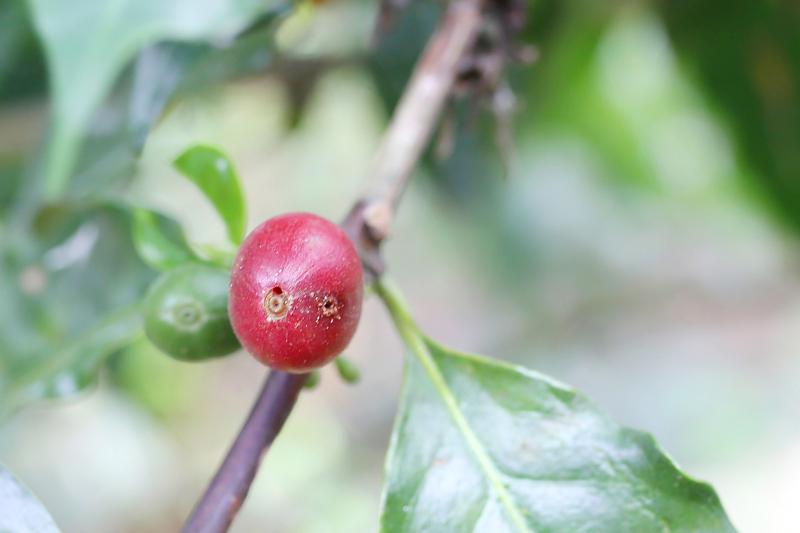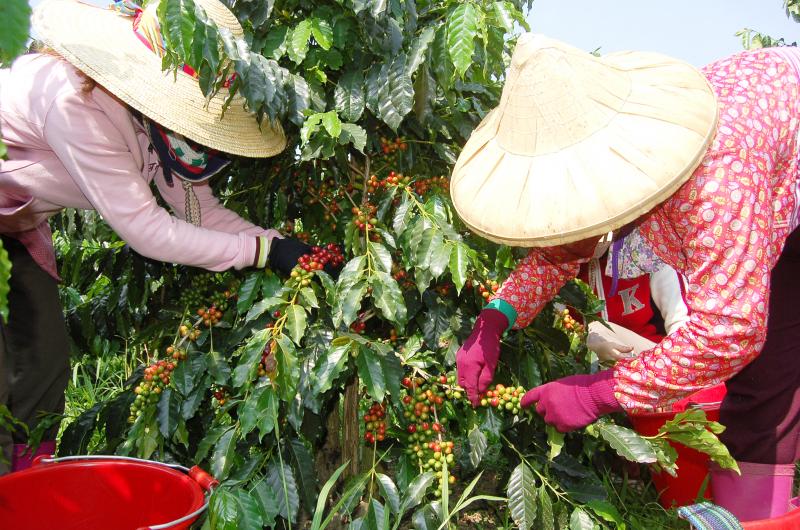There are 225 hectares of coffee plantations in Pingtung County — the most of any county in Taiwan. It is now coffee harvest season in the county. However, while harvesting this year’s crop, Pingtung County’s coffee farmers discovered an infestation of the coffee borer beetle, which has already ravaged coffee crops in central and northern Taiwan. The pest has significantly depleted this year’s coffee harvest — by 30 percent, according to data published by Pingtung County Government Department of Agriculture. The department has called in experts to help investigate and assist farmers with preventative measures to suppress the beetle’s spread.
Pingtung’s coffee farms are mostly located along the Dawu mountain range, but in recent years farmers have begun to grow coffee in flatland areas. According to local coffee farmers, this is the first time that their coffee plantations have suffered from blight, so they lack knowledge in how to deal with it. As the amount of land set aside for growing coffee in Pingtung has increased, farmers say cultivation management and blight problems have come to the fore.
The coffee borer beetle is tiny and burrows into the coffee fruit to extract food and lay eggs. The beetles also reproduce rapidly: a single beetle typically lays between 30 to 60 eggs inside the fruit. Damaged fruit withers and dries out, while bacteria within the cavity left by the beetle may produce fungus growth, leading to a higher “bean float rate” when wet processing the beans after harvest.

Photo: Chiu Chih-jou, Liberty Times 照片:自由時報邱芷柔
Removing “floating beans” is the first step during processing coffee beans. Farmers place the freshly harvested beans into large containers of water. Ripe beans are heavier, so they will sink to the bottom, while lighter unripe or inferior beans float on the surface.
Pingtung County Government Department of Agriculture says it is using traps to prevent the beetle from spreading further, and officials stress that the best time to carry out prevention measures is when the coffee plants are flowering. The department says that, in addition to working with experts from the local agricultural research and extension station, it is also providing coffee farmers with education on steps they can take to inhibit the coffee borer beetle’s spread.(Translated by Edward Jones, Taipei Times)
屏東縣咖啡種植面積達兩百二十五公頃,居全國之冠。正值咖啡採收季節,屏東咖啡農卻發現,原本肆虐中、北部咖啡產區的「咖啡果小蠹」大舉入侵屏東,造成產量大減。屏東縣政府農業處統計,今年整體產量約減少百分之三十,將邀專家會勘,協助農民進行防治作業,避免疫情蔓延。

Photo: Chiu Chih-jou, Liberty Times 照片:自由時報邱芷柔
屏東咖啡農戶指出,大武山沿線都有咖啡園,近年許多平地也加入種植行列,過去沒有病蟲害問題,因此農友相關防治知識不足。隨著種植面積及不斷增加,栽培管理及病蟲害問題也浮出檯面。
咖啡果小蠹蟲體細小,會鑽入果實取食、產卵,且繁殖速度快,一隻雌蟲在一粒果實內就可產下三十至六十粒卵,受到危害的咖啡果實會整顆枯乾,果實遭蛀洞後,增加細菌、真菌入侵機會,讓「浮豆率」跟著提高。
「去除浮豆」是咖啡製程的第一個步驟,農民將採收的咖啡果倒入大水槽,成熟飽滿的果實會沉入水底,發育不完全的劣質豆會浮上水面。
縣府農業處表示,目前多以「咖啡果小蠹誘殺器」進行防治,每年咖啡開花期是防治咖啡果小蠹最好的時機,縣府將會同農改場等專家共同勘察,並透過講習,協助降低害蟲數量減緩蔓延速度。
(自由時報邱芷柔)

詞法—不定詞的誤用 1. 我得記住星期五要把報告寫好。 ˇ I must remember to finish my report by Friday. χ I must remember finishing my report by Friday. 註︰remember 後面跟動名詞或不定詞表示兩種不同的概念,與 forget 相類似。 試比較下列句子: I remember meeting him somewhere.(我記得曾經在某處見過他。) I must remember to meet him at the station at six this evening. (我必須記住今晚六點得去車站接他。) He remembered turning off the light when he left the room. (他記得離開房間時曾先把燈熄了。) Remember to turn off the light when you leave the room. (記住離開房間時要把燈關了。) 2. 他提醒她做好她份內的事。 ˇ He reminded her to do her job. χ He reminded her of doing her job. 註︰remind ... of ... 後面跟動名詞,表示「使人想起做過某事」。若是「提醒某人應做某事」,應用 remind ... to do ...。試比較下列句子: He reminded me of my attending the lecture last Friday. (他讓我想起我上星期五去聽過那次演講。) He

★ Bilingual Story is a fictionalized account. 雙語故事部分內容純屬虛構。 “Any New Year’s resolutions?” he asked. Lena put her coffee down. “Yeah,” she said. “To get in shape.... round is a shape, right?” Mark chuckled. “I support this. Fully achievable. Low risk.” “Thanks,” she smiled and lovingly rubbed her round belly. “I like a resolution I can’t fail.” “Funny thing is, I was thinking about getting round too.” Lena nodded her head in approval, “You could put some meat on those skinny bones of yours.” Mark shook his head, “Not that kind of round. Wheel-of-Life round.” She raised an eyebrow.

A: Apart from Taiwan’s A-mei, Mayday and Jolin Tsai, there are many foreign singers coming to Taiwan early this year. B: The South Korean girl group Babymonster are playing two shows at Taipei Arena starting from tonight. Who else is coming to Taiwan? A: Other artists include Australian band Air Supply, K-pop superstar Rain, boy group Super Junior, TXT, US singers Giveon and Josh Groban, and Irish boy group Westlife. B: Air Supply was the first foreign band to come to Taiwan in 1983, and they’re probably the most frequently visiting group too. A: As the year is beginning

對話 Dialogue 清清:最近天氣越來越冷,感覺很容易感冒,要不要一起去吃薑母鴨或是羊肉爐? Qīngqing: Zuìjìn tiānqì yuèláiyuè lěng, gǎnjué hěn róngyì gǎnmào, yào bú yào yìqǐ qù chī jiāngmǔyā huòshì yángròulú? 華華:最近我覺得有點累,想吃薑母鴨,可是又怕一下子吃太補會上火。 Huáhua: Zuìjìn wǒ juéde yǒudiǎn lèi, xiǎng chī jiāngmǔyā, kěshì yòu pà yíxiàzi chī tài bǔ huì shànghuǒ. 清清:那我們去喝香菇雞湯吧,不太容易上火,喝了也會很暖和。 Qīngqing: Nà wǒmen qù hē xiānggū jītāng ba, bú tài róngyì shànghuǒ, hē le yě huì hěn nuǎnhuo. 華華:聽起來不錯!你們家平常冬天都吃什麼進補? Huáhua: Tīng qǐlái búcuò! Nǐmen jiā píngcháng dōngtiān dōu chī shénme jìnbǔ? 清清:我家都煮麻油雞,吃完整個人手腳都會熱起來。我也很久沒喝香菇雞湯了,正好可以去打打牙祭。 Qīngqing: Wǒ jiā dōu zhǔ máyóujī, chī wán zhěnggè rén shǒujiǎo dōu huì rè qǐlái. Wǒ yě hěn jiǔ méi hē xiānggū jītāng le, zhènghǎo kěyǐ qù dǎ dǎ yájì. 華華:可是我最近在減肥,會不會吃得太補,肉又長回來了? Huáhua: Kěshì wǒ zuìjìn zài jiǎnféi, huì bú